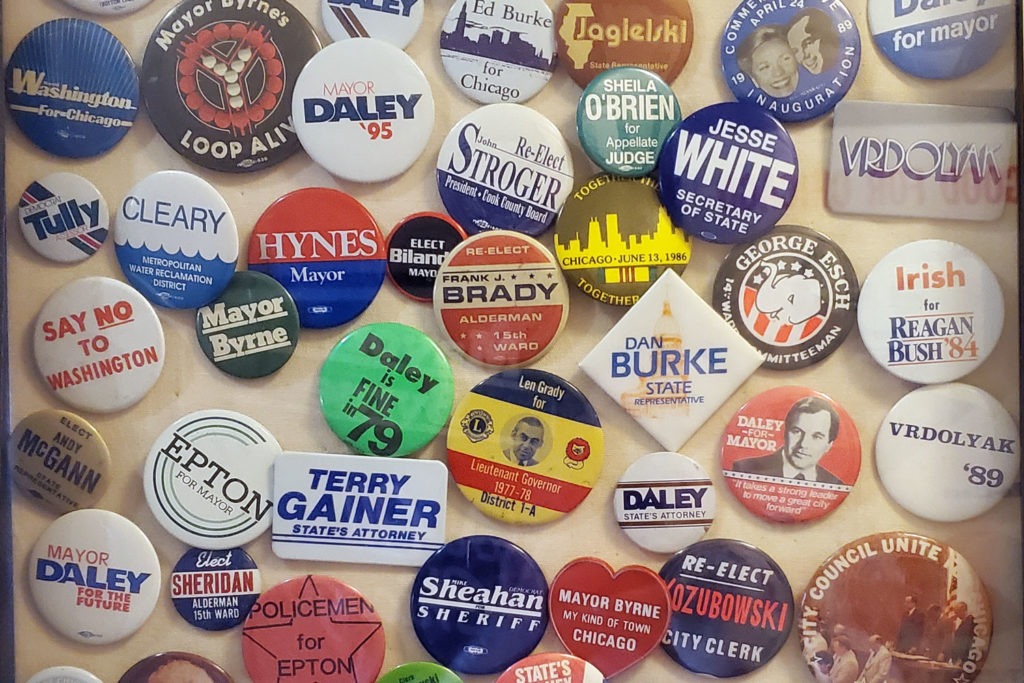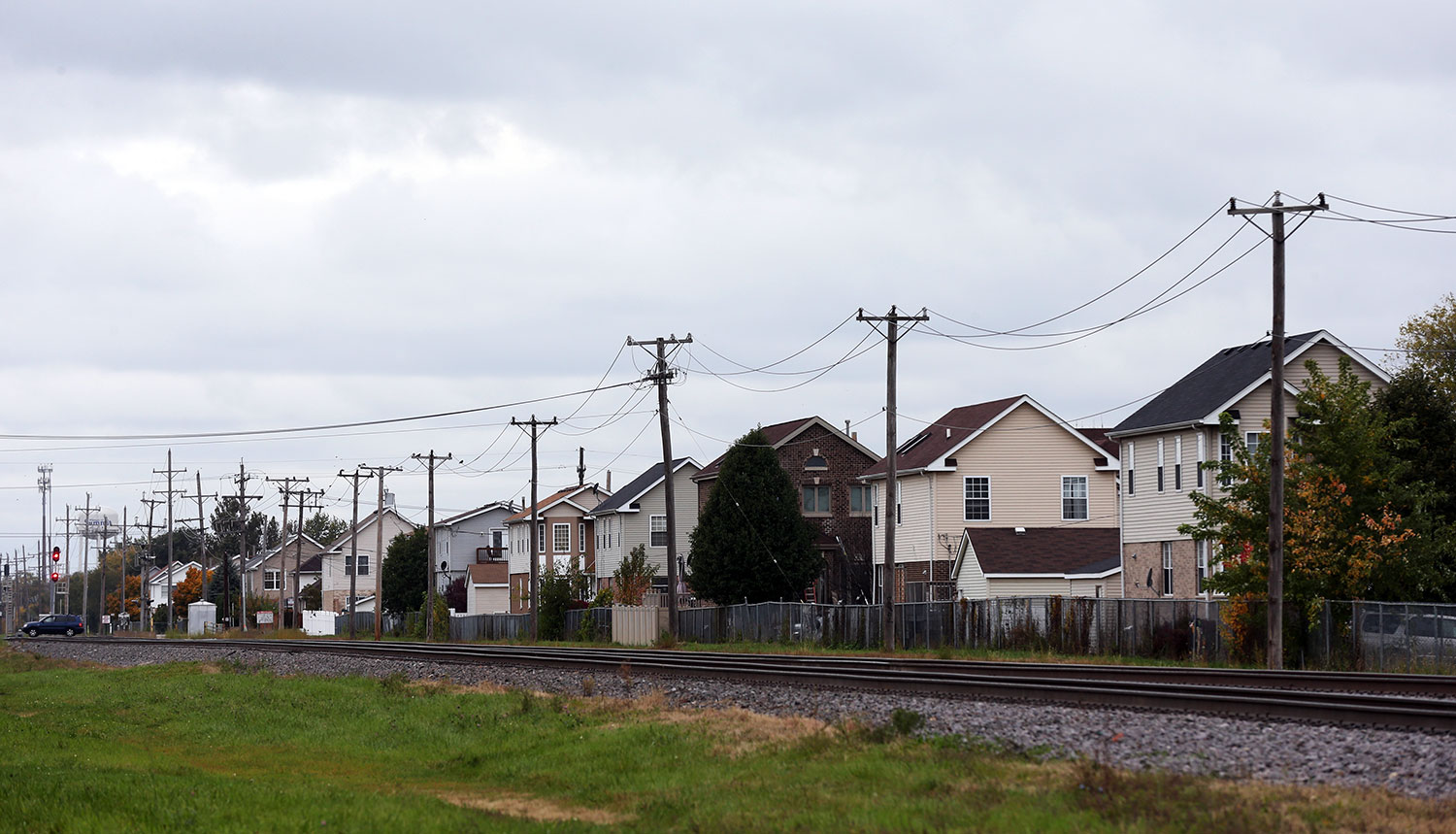Join us on a journey to one of the least-explored corners of Chicago: the Land Beyond Midway. Consisting of the twin neighborhoods of Garfield Ridge and Clearing, this land extends two miles west of the airport, from Central Avenue and Harlem Avenue. A map of Chicago is said to resemble a face, looking westward. If that’s the case, the Land Beyond Midway is the nose. It’s a low-rise neighborhood, of bungalows, bakeries, dental offices, and taquerias; not urban, but not quite suburban, either, making it a popular hideaway for cops, firefighters, and the Streets and San man. Only Mount Greenwood and Norwood Park house more city workers than the Land Beyond Midway.
A visitor to the Land Beyond Midway will be shocked by the omnipresent sight and sound of jet airplanes. A Frontier Airlines Airbus A320 looks enormous, skimming fifty feet above the intersection of 63rd Street and Central Avenue, so close to the street that pedestrians can read the ID number on the fuselage, and can’t hear themselves talk over the roar of jet fuel. The planes come in for a landing at Midway Airport every few minutes. Living so close to a runway can be dangerous for the inhabitants. On a snowy day in 2005, a Boeing 737 slid through a noise wall and crashed into two cars on Central, killing a 6-year-old boy.
“It doesn’t even faze me,” said Lynn Young, who can see the airport out the window of her bungalow. “I grew up near the railroad tracks. If you’re outside and you’re on the phone, though, it does get annoying.”
Young lives near the corner of 63rd and Parkside, and works down the street at Cafe 63, Clearing’s neighborhood diner. You know those diners where TV crews venture to get the views of the Regular Guy? That’s Cafe 63. With so many residents drawing a paycheck from City Hall, this is a political neighborhood, so owner Dale Andrews has adorned it with political memorabilia, most of it memorializing the Chicago Machine. Behind the counter is a campaign poster for Mayor Richard J. Daley (A Daley Reminder. Get Things Done for Chicago with…Richard J. Daley. Democratic Candidate for…Mayor). Across from the bathroom door is a framed collection of campaign buttons, most advertising Irish or Polish names, many dating back to Council Wars: Washington for Chicago. Say No to Washington. Vrdolyak. In 1983, the 23rd Ward gave Harold Washington his lowest vote total: 3 percent.

“It’s a great neighborhood,” Andrews said of the Land Beyond Midway. “The amount of blue-collar guys and the cops. I have quite a large police clientele. These neighborhood people wanted me to put ‘No Firearms’ stickers on the door. Three-quarters of my customers have firearms! You’re in the city, but it’s also got a suburban feel. It’s a very tight-knit neighborhood, very cliquey. You go down any block, there’s ten houses owned by city workers.”
Andrews stood up to greet a couple walking in the door.
“How are youse doing?” he asked, like a true Sout’ Sider.
When he sat down again, Andrews explained that his diner is a popular spot for politicians trying to connect with the average voter. When Rahm Emanuel was mayor, he came in with two bodyguards, sitting at “the politician’s table” by the window. Former city clerk Jim Laski, who lives in Clearing, is a regular. So is 23rd Ward Ald. Silvana Tabares. Politically, the Land Beyond Midway is “heavy Democrat,” Andrews said. “The one hand washes the other principle. That’s been going on in this neighborhood since the ’40s and ’50s. Not as heavy as Bridgeport, but no place is as heavy as Bridgeport.”
As Cafe 63’s button collection indicates, these are conservative Democrats. Every precinct west of Narragansett Avenue voted for Donald Trump in 2020, although not as heavily as Mount Greenwood. Latinos, who recently became the largest ethnic group in the Land Beyond Midway, spoke anxiously of seeing Trump flags dangling above stoops. Andrews estimates the Land Beyond Midway is 30 percent Polish immigrants, 40 percent Latino, and 30 percent “Dad was a plumber for the city and they’re Irish.” Latinos make up three-quarters of the student body at John F. Kennedy High School, but are unlikely to become as overwhelming a presence as in Archer Heights and Brighton Park, because of the area’s popularity with city workers.
“That’s what keeps our neighborhood good,” one resident said. “That’s what keeps it going. That keeps the riff-raff out. There’s only us, Mount Greenwood and the Northwest Side.”
The Latino population inspired Beat the Streets executive director Mike Powell to open a youth wrestling gym on Archer Avenue in Garfield Ridge. Beat the Streets offers free wrestling training for Chicago Public Schools students. On a recent afternoon after school, a dozen young people, most Latino, were jogging across the mats and kneeling to practice their holds. Among them was 8th grader Giancarla Garduno, of Brighton Park, who hopes to test into Lane Tech next year and join the girls’ wrestling team.
“A friend of mine, she was like, ‘You want to wrestle?’ I was like, ‘Sure,’” Garduno said, explaining how she adopted the sport. “I like that you can be aggressive, the environment. I just like throwing people and people throwing me.”
Since its goal is diverting teenagers from gang activity, Beat the Streets offers tutoring and free meals. The mottoes on its walls are: ACCOUNTABILITY, GRATITUDE, GRIT, INTEGRITY. (On the day we visited, the gym also offered boxes of Danish from Weber’s Bakery. No article about the Land Beyond Midway is complete without a reference to Weber’s. Reflecting the neighborhood’s Polish heritage, it’s one of the city’s most popular spots for paczki, opening at 4 a.m. on the big, pre-Lenten Tuesday.)
“Today, I picked up four kids from school, and they’ll do their homework,” coach Bobby Campos said. “We’ll get them food, something healthy, like bagels. Wrestling is something to get their anger out. It’s not fighting, not boxing, but it’s still pretty physical and hands on.”
Garfield Ridge “is right in the middle of where the kids are,” Powell said. “I’ve got kids from every direction. Garfield Ridge needs something like this. It didn’t have any wrestling. It has a very rich wrestling tradition. The Bittum Cats was once based here. They have gone to the suburbs, kind of a microcosm of what’s happened in the city and Garfield Ridge. We are geographically and financially accessible to city kids. The pay-to-play model that exists in youth sports is not here. We want to mix races, cultures, socioeconomic classes. We have a very heavy cop and firefighter kid contingent, but we still skew 75 percent Latino.”
The Latinos are moving to the Land Beyond Midway for the same reason the Poles and the Irish before them did: it’s one of Chicago’s safest neighborhoods. According to the Sun-Times, there hasn’t been a single homicide in Clearing or Garfield Ridge this year. It’s one of Chicago’s quietest, too — except for those planes.



